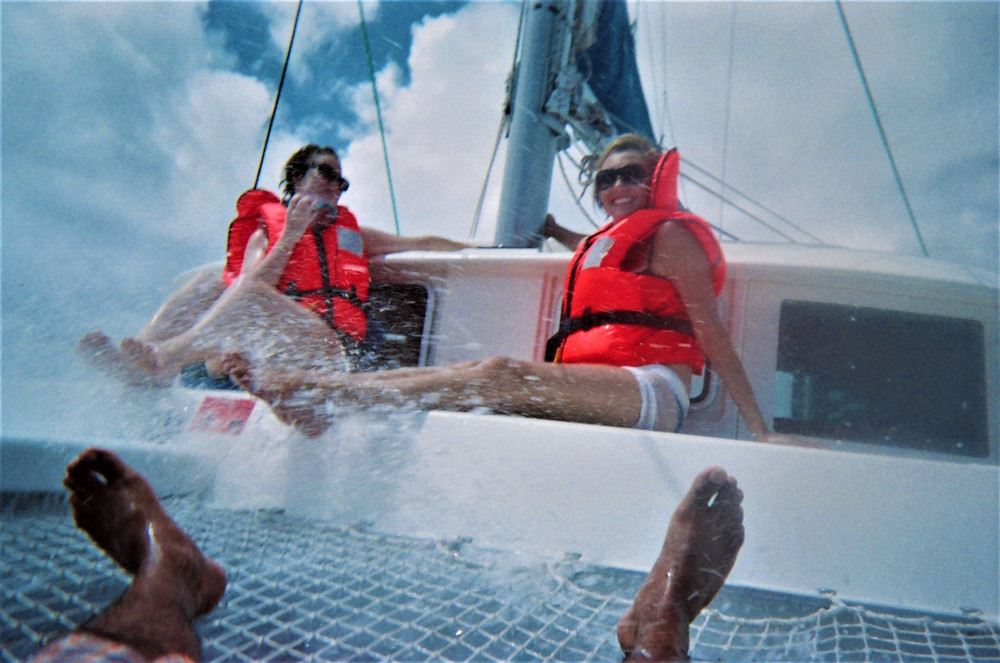
The Lagoon 380 is an entry level cruising catamaran. However, at 38 feet with a list price of $400k, it is not an entry level boat.
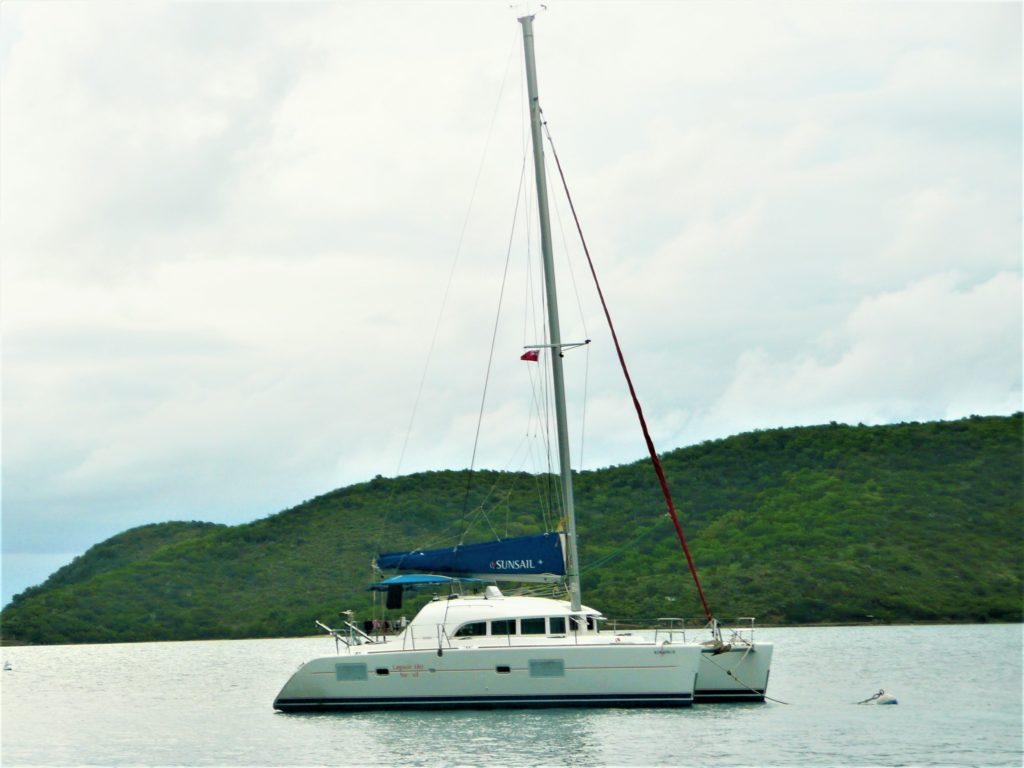
Pros
- Benefits of a modern cruising catamaran at an entry level price
- Simple boat means less to go wrong
Cons
- Feels small fast with a crew of six to eight, especially the refrigerator
- Relatively tight cabins require climbing into bed from the foot
- Knotted trampoline design is less comfortable than others
- Less engaging sailing experience, especially in low wind
Sailing the Lagoon 380
You’ll need a crew because there is a lot of ground to cover. While I’ve seen some of these boats with all lines led to the helm, most have the starboard (right) jib sheet on a separate winch on the starboard side of the cockpit (rear deck). Plan on using two winch handles to avoid having to run it across the wide deck between tacks. All of the lines are led through rope clutches to the self-tailing winches. The mainsail is stored in a lazy bag and the jib is roller furling, making both are easy to raise and lower.
The mainsheet traveler runs along the back of the cockpit bench. Because you’ll be under the cockpit cover while adjusting it, you won’t be able to see the sail at the same time. The jib sheet travelers are on each side of the roof, and very easy to access, but you do have to venture forward of the cockpit to get to them.
The largest boat I had experience sailing prior to this was a 30-foot Catalina. Compared to that boat, the Lagoon had a LOT of sail. The main was heavy, but very manageable being stored in a lazy bag. With roller furling, the jib, too, was very straightforward. The sail controls were simple and we never felt over our head; but we did not have a chance to experience heavy wind.
The boat has almost no heel under sail, compared to monohulls. It takes a lot of time to build momentum. So, you don’t get much response from the boat when trimming the sails. Most of our sailing was in light wind, around five knots. We found it hard to make way at this speed, while back home in monohulls and dinghies, five knots is sufficient wind to make way. I’ve read this is a fast boat, but it needs a lot of wind to show its colors…or a more accomplished crew.
Piloting the Lagoon 380
I was worried that visibility would be limited from a helm seat that sits behind the house in the back corner of a long, wide boat. However, I could see very well from the helm. It was hard to judge distance of anything close to the starboard side. This problem is solved by avoiding close quarters maneuvering on that side and bringing the port (left) side alongside docks or other boats where it was easy to see the edge of the hull from the helm seat, or even hop down from the helm to the side rail for a closer look.
The crew, on the other hand, cannot see over the house while sitting at the cockpit table. They’ll need to share the helm seat, stand up, or move to up towards the bow to see better. Keep this in mind if you have anybody on the boat that is at risk for sea sickness because seeing where the boat is going can help.
The only helm is outside, so if you want to run the boat in the weather, you’ll be in the weather. However, there is a retractable cover over the helm that can help keep you dry when bad weather hits.
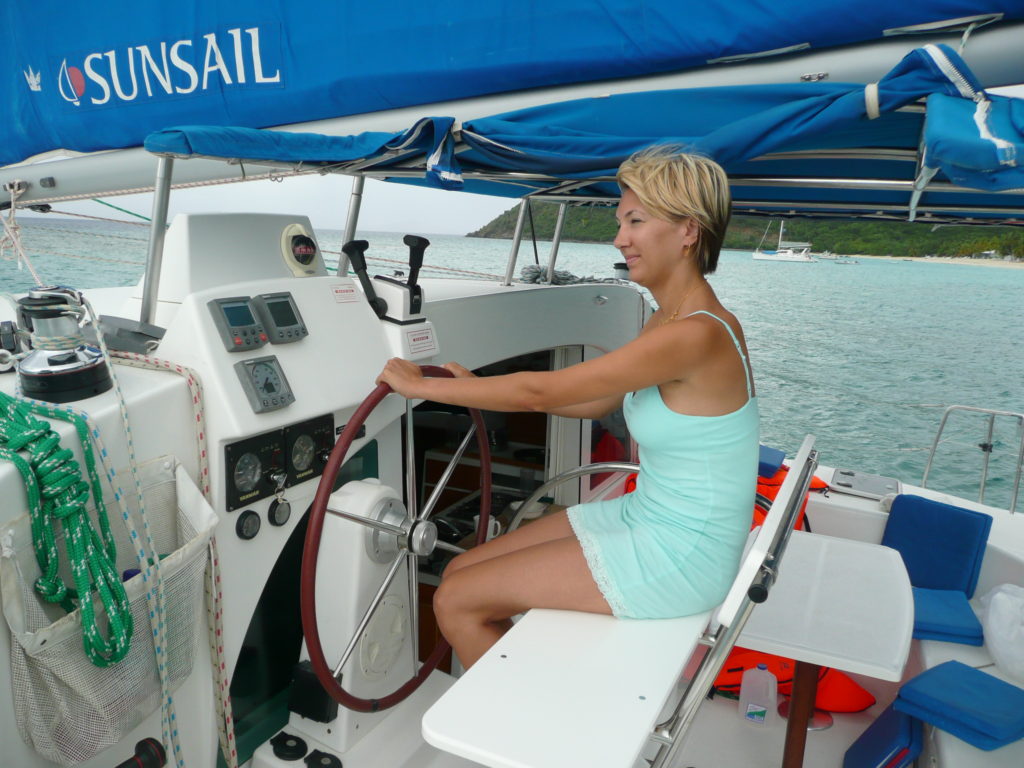
Electronics
Our boat did not have a chart plotter at the helm. Rather, it was hung above the nav station in the cabin, similar to smaller monohulls that don’t have space for mounting electronics at the wheel. The VHF was mounted here too. This was still an improvement on monohulls because the station was very accessible from the helm: just hop down and lean in and to the left through the cabin door…a navigator can easily move from the nav station toward the helm station to assist, as well as look out through the cabin windows toward the bow.
Our boat, and most Lagoon 380s, are equipped with Raymarine autopilot and instruments at the helm. This is a very common product, so you may have had experience with it on other boats. I had previously used Furuno, which has a nob to turn the autopilot. I had assumed the Furuno nob was more intuitive, but found the +1/+10 degree buttons on the Raymarine autopilot to work even better. If you need to turn more than 1 or 10 degrees, just tap the button multiple times until you’ve set the desired heading and the boat will gently turn toward that heading.
There’s not much to say about the wind and water instruments, which worked as you’d expect. But I’m grateful to have them as not all boats are so equipped, necessitating your own senses for the impact of wind, and reliance on the chart plotter for depth and speed. Having more info helps you be a better pilot:
- Comparing your water speed to GPS speed (‘course over ground’), as well as your GPS heading to your compass heading tells you how current is affecting your boat’s movement.
- A depth sounder gives you additional confidence to keep from running aground by not relying solely on charts. It also helps you confirm your location on a chart based by matching the chart depth to your sounder depth.
- Wind speed and direction is incredibly helpful for sailing, but it is also helpful to understand how the wind will move you when docking.
With all that said, our water speed transducer was stuck and we could not take a reading.
Engines
Speaking of speed, we traveled at around 5.5 knots (6.3 MPH) under power at about 3,000 RPMs. Our boat was equipped with two 20hp 3YM20 Yanmar diesels. The engines are rated to run continuously at 3,489 RPMs for 19 horesepower with a max RPM of 3,600 RPMs for 21 horsepower. We thought the engines sounded comfortable at 3,000. When we ran the engines up closer to full throttle, the port engine burned enough oil that the girls thought the boat was on fire. But backing it down to 3,000 it ran just fine.
Many 380s come equipped with 27-30hp engines that should cruise comfortably at 6.5kts. Get the bigger engines if you can. When leaving Road Town on our first day, we ran into a lot of current passing through the breakwater. We slowed almost to a stop and had very little control of the boat. This wasn’t a great way to get comfortable and build confidence on our rental. You can never have too much power.
Cruising catamarans like the Lagoon 380 have twin engines, one in each hull. Having twin engines, especially spaced far from the centerline, make docking a cinch. When approaching a harbor, just leave the wheel centered and turn the boat by bringing the engines in and out of gear independently. To turn the boat in its own length, just put one engine in forward and the other in reverse.
Another advantage of the catamaran layout is that the engines are well isolated from the helm, cabin and cockpit, which sit above and between the hulls that contain the engines. This makes for a much quieter ride.
Theoretically, twin engines are less fuel efficient than single engines. However, you can reduce fuel consumption on a twin by cruising (slower) on a single engine. We had to do this when our prop was fouled (see below) and it was possible to in a straight line, but almost completely impossible to turn towards the side of the running engine.
Living Space
The social and gathering space in the Lagoon 380 is situated on the deck that sits above the two hulls. This gives you a lot more open space and light than you’d have on a similar length monohull.
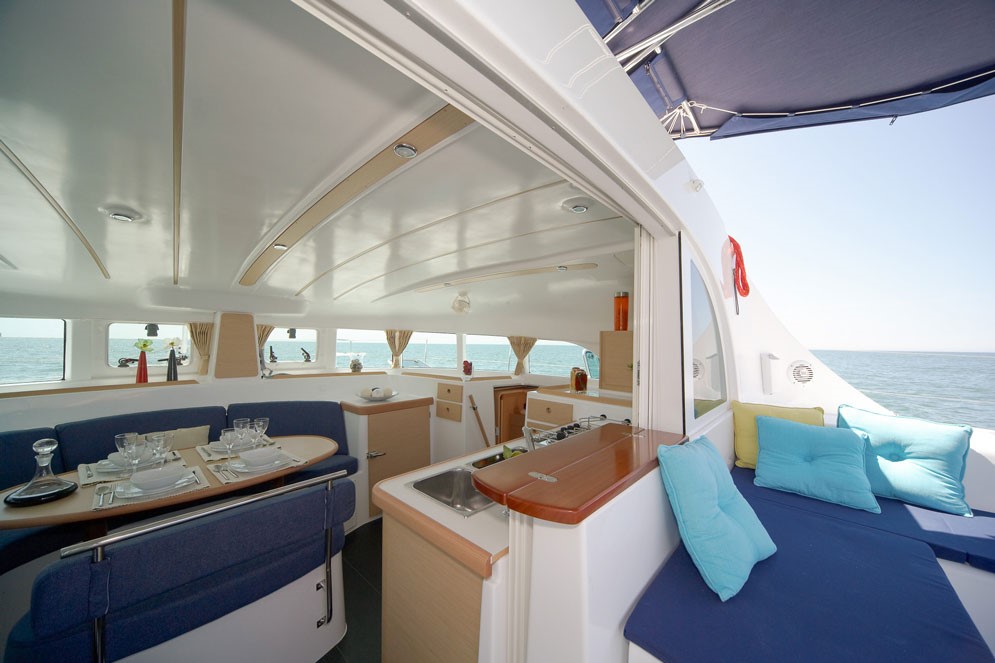
On the Lagoon 380, the galley (kitchen) is located in the rear of the main cabin against the cockpit. This makes it very convenient to both the dinette in the cabin as well as the cockpit area, which contains a table and bench as well as the helm. In fact, there is a window over the countertop that slides open so that the countertop can be extended out into the cockpit to pass beverages out and dirty dishes in. The galley has a three-burner propane stove and oven as well as a two-bin sink. The sink has hot and cold fresh water as well as a foot pump for sea water; the foot pump is handy to rinse dishes without using fresh water or turning on the water pump.
Lagoon 380 S2 salon
The dinette in the cabin has a molded in bench against the front of the cabin that spans most of the width of the area. There’s also a smaller bench on the other side of the table. Both benches have storage below the cushions; this is where the charter company had all of our safety gear stowed. This seating area would be very tight for eight people. The small table in the center cannot accommodate a crowd that size for any more than drinks.
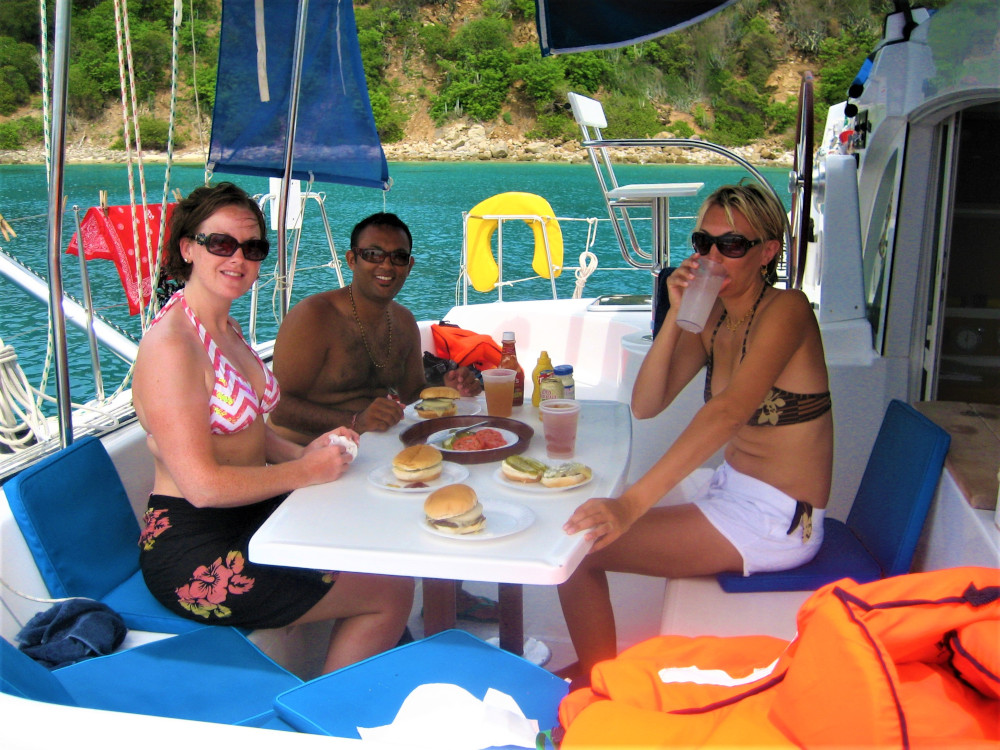
The good news is there’s plenty of room to spread out on this boat. There’s an additional seating area with a larger table in the cockpit. The wraparound bench in the cockpit is molded into deck: you can either step down into it from the stern or the starboard (right) side, or you can slide into it from the center of the cockpit…this does require some scooching and makes it hard to get in and out when a group is sitting down. Like the benches in the cabin, there’s storage underneath. The bench closest to the galley lifts entirely from the floor, making it a great place to slide in heavy coolers.
Below Deck
Most Lagoon 380s built for charter have four staterooms: each hull has one bed in the bow and one in the stern, with a bathroom between. The owners version’ has one hull with two staterooms and the other hull equipped with a larger master stateroom at the stern (primarily addes a sitting area), a larger bathroom located in the bow (with a separate shower stall), and more storage and a desk toward the middle. Even with only three couples, we liked the four-stateroom layout as we could use the extra stateroom for storage.
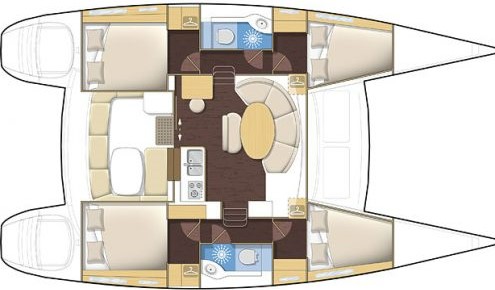
Sleeping Accommodations
The beds are sufficient for a couple. However, they run the full width of the stateroom, so you have to climb in and out from the foot (or head, depending on how you sleep). This can be awkward, especially since they sit a bit high to make room for storage and mechanical equipment underneath.
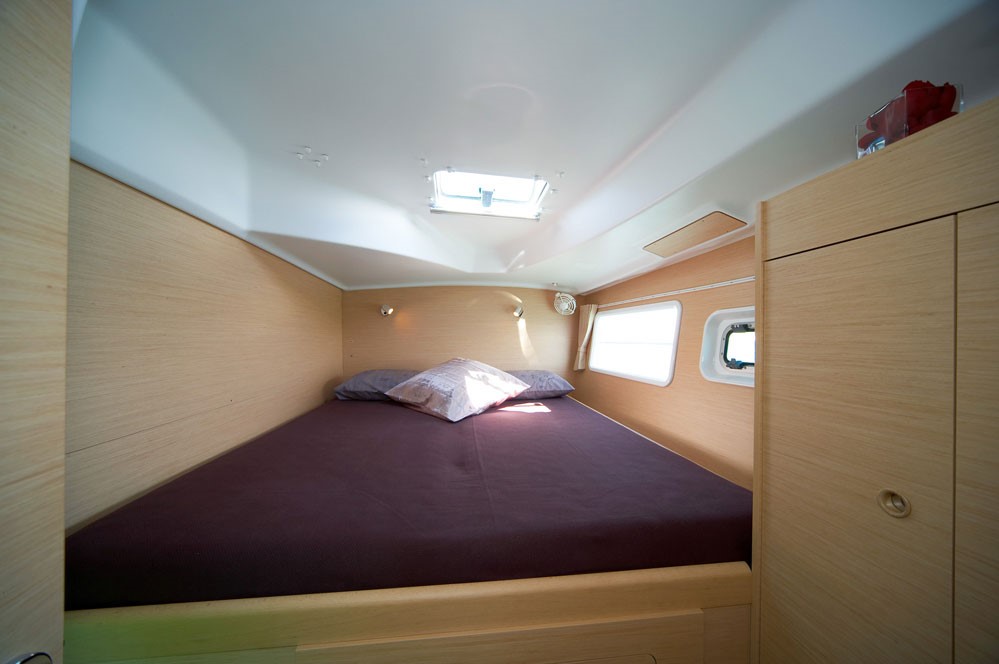
The beds in the bow are a bit narrower and taper toward the foot.
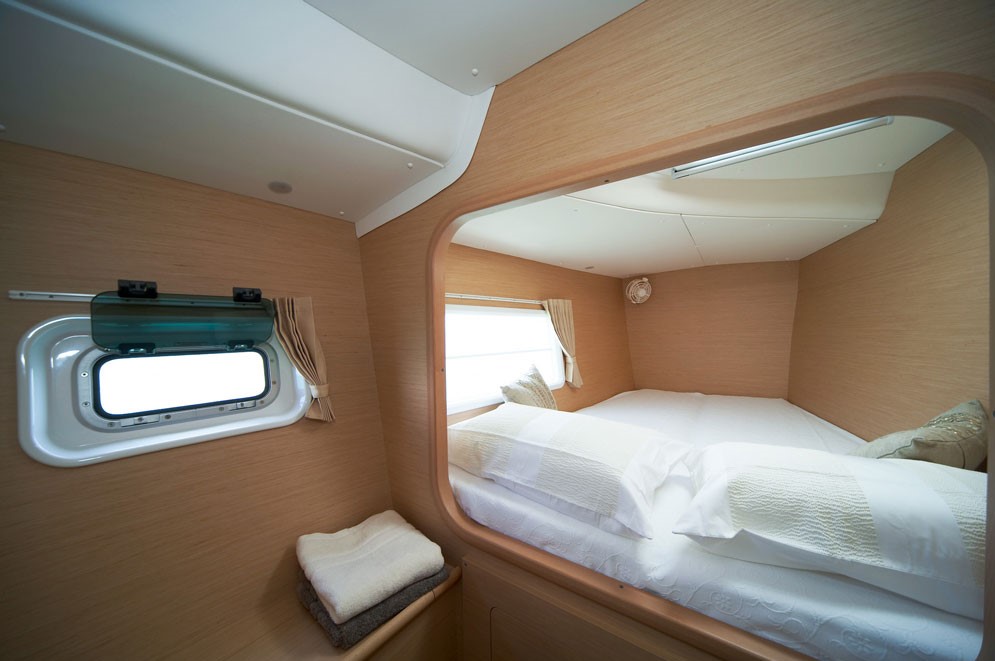
Storage
All staterooms have some cubbies and a small hanging closet, but the rear staterooms have a bit more storage space. If your charter company doesn’t include hangers in the closet, it’s pretty useless because it has a taper that follows the hull line, making it difficult to stack anything from the bottom. The doors to the hallway open into the staterooms and block the storage when open, so you have to enter the room, then close the door to get into the ‘closet’.
There are also storage lockers in the bow of each hull that you’ll access through a hatch on each deck; it is unfinished, unlit, and deep; so you really need to bag up anything that goes in there to keep it dry and make it easy to get it out. They seem to be used primarily to store lines (rope) and fenders.

Bathrooms (Heads)
The bathrooms are generous when compared to smaller boats. There’s a ledge around the sink to set your toiletries. Four stateroom boats lack a separate shower stall, so there’s a drain on the floor between the toilet and the sink for showering. A larger bathroom might make sense if you need space for advanced hair and makeup work…but you won’t be able to use curling irons or hair driers on most of these boats since they don’t have 120-volt electrical systems.

The Trampoline
One feature that really sets cats apart from monohulls is the trampoline. The trampoline is a comfortable place to enjoy warm weather at anchor or under way in calm seas. In fact, we spent very little time on the beaches because we had such a nice spot on our little ‘private island’. Most power catamarans have a hard deck and that’s becoming common on newer sailing cats as well. Hard decks have advantages in rough seas when the bow gets stuffed into waves in rough seas. In calmer waters that most charterers like us will find, the tramp is hard to beat.

The Lagoon 380 trampoline is made from knotted rope. This is very secure, drains well, and provides good traction. However, it is less comfortable than mesh or webbing to lay on because the knots dig into your skin. Plan on putting a cushion or life jacket down to lay on.
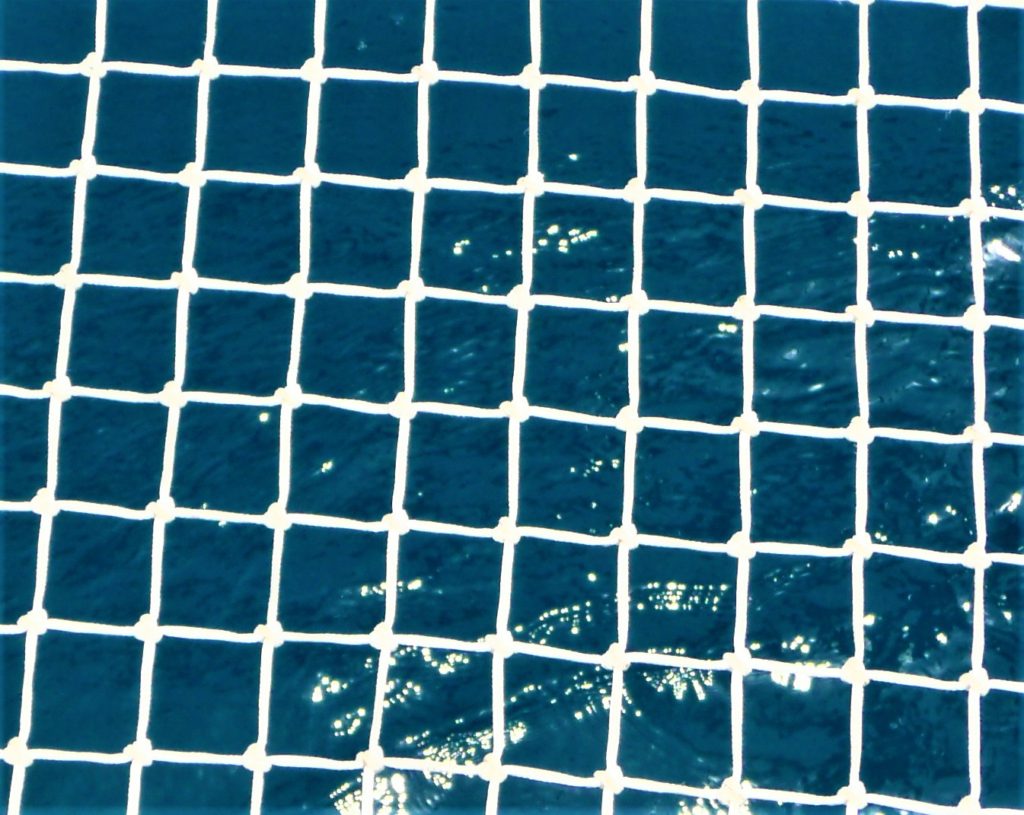
Mechanical
The Lagoon 380 has the mechanical simplicity of a traditional monohull sailboat. It has a 12-volt electrical system powered by the engine alternator. Most of these boats do not have a 120-volt system, with no generator or inverter. While this reduces cost and increases simplicity, it also means: no microwave, no air conditioning, and no using 120-volt appliances, such as hair dryers, toasters, or blenders. Some boats have an air conditioning system that works on shore power, but that’s totally useless if you are at anchor or on a mooring ball.
Ventilation
Each stateroom and the main cabin have fans to circulate the air. This definitely helps to take the edge off a warm humid evening by circulating the air and bringing more fresh air into the space. There’s also a hatch over each bed and bathroom as well as several in the main cabin for fresh air.
Plumbing
There are two separate water tanks that you must switch between. So you can breathe easy on your first tank to determine how quickly your crew is using it. Then, if it runs dry too fast, ask everyone to conserve when you switch to the second tank. I was very stern with water use expectations on our weeklong trip. We ended up using about half of the first tank the whole week. This almost led to mutiny, so learn from my mistakes.
On our boat, the starboard (right) engine charged the batteries and heated the water. So, you’ll need to fire it up before showering to heat the water and run the water pump. Leave it running while the full crew has a go, and you’ll top up the batteries at the same time. Boats with cabin heat or 120-volt electrical can have different systems for water heating.
All sinks have foot pumps for sea water to reduce freshwater use when washing your hands or rinsing dishes. It also reduces the need to turn on the water pump.
The toilets are manually operated. This means you turn a pump handle one way and pump water into the bowl. Turn the handle again to pump the nasty stuff into the holding tank. It sounds simple, but it is less pleasant than your toilet at home.
Like most cruising sailboats, the Lagoon 380 has manual lever operated bilge pumps in the cockpit in addition to automatic electric pumps. Since there are two hulls, there are two separate sets of pumps.
Anchor
As you’d expect on this size boat, there is an electric anchor windlass to make anchoring easier. However, unlike in monohulls, the windlass is located behind the trampoline, a good ten feet away from the anchor roller on the bow next to the jib furler. This means it’s ideal to have two crew members operating the anchor, in addition to another crew member at the helm.
Refrigerator
The refrigerator works, but it is small and there is no freezer. This can be quite tight to feed a crew of six to eight for a week. Moreso if you are trying to keep a lot of fresh produce from rotting in a tropical climate. There is space for coolers under the seats in the cockpit; most charter companies will provide coolers and ice at the base. This is more effective in northern climes where ice holds longer in a cooler.

Dinghy Davits
Most monohull sailboats require you to tow your dinghy behind the boat or carry one light enough to lift onto the bow. However, most cruising catamarans have davits at the stern between the hulls to lift the dinghy out of the water. Carrying the dinghy on davits reduces drag from towing and eliminates the need to watch out for the dinghy painter (rope) when docking to keep it from fouling (tangling around) the prop. You also won’t need to worry about it filling with water in rough seas. This configuration is not only a significant improvement compared to towing or storing on the bow of sailboats. It is also faster and easier to deploy than common powerboat techniques, such as hoisting on the flybridge or rolling onto the swim platform.
I will say, however, that our boat lost the dinghy while under way in some rough waters. A rope that had been previously repaired failed dropped one side of the dinghy into the water. The rope then got tangled in one of the props, forcing us back to the charter base for a quick repair. I blame the rope and not the boat’s design.
Options to Look For
- A BBQ keeps heat and food smells outside. Propane is easier to provision for and operate than charcoal.
- A chartplotter located at the helm makes navigation easier, especially if cruising shorthanded or single-handed in shallow waters.
- If you are planning to motor a lot, larger (~30hp) engines will get you there faster or more efficiently.
- While the canvas bimini over the cockpit on our boat was completely sufficient, even in the rain, a hardtop has a cleaner look.

Catamaran Advantages
- Spacious trampoline for sunning
- Light, open main cabin and galley
- Roomy cockpit for dining with the caveat of low visibility that can contribute to sea sickness and less engaging voyage.
- Up to four staterooms and two full bathrooms in under 40 feet
- Convenient davits for dinghy storage
- Relatively quiet cruising with engines running
- Plenty of water and fuel: 270% more water and 30% more fuel than a 40-foot Beneteau (monohull)
How Much Does it Cost and Where Can I Rent a Lagoon 380?
Lagoon built this model from the late 1990s into 2019. Being a very popular boat for charter service, it is still easy to find today. Sunsail has, unfortunately, given up on her and other entry level cats as the market demands air conditioning and other little niceties…at a premium price of course. Here are a few examples of models currently in bareboat service:
- TMM Yacht Charters in the British Virgin Islands has a 3 Cabin Version for $4,350-$6,800 per week, depending on season
- Dream Yacht Charters has a 4-Cabin Version also located in the British Virgin Islands for as lows as $3,800 per week off-peak. They feature 3 and 4 cabin versions in many of there other bases as well.
What Kind of Experience do I Need to Rent a Lagoon 380?
Charter companies will expect the crew to have experience:
- Handling twin-engine boats. This is a simple but important point that docking these boats is different than docking a monohull, although I think its far easier once you know how. You might not be able to find a catamaran to rent to train on where you live, but an experienced sailor can learn the concepts on any powerboat with twin-engines…in less than an hour. If you want more in depth training on catamaran handling, the American Sailing Association offers ASA 114, a cruising catamaran certification.
- Handling similarly sized boats. That means boats over 30 feet at a minimum.
- Sailing a cruising yacht. You can’t just promise not to use the sails, you must know how to operate the sailing rig. A great way to get this experience is through a Certification Program from the American Sailing Association.
Where the skipper (leader) falls short in some of these areas, a crew that also has strong experience can complement.
Similar Yachts
The Mahe 36 is another great value option to get into a catamaran. Like the Lagoon, it has no air conditioning or generator. Being a bit shorter, the Mahe 36 only comes with one bathroom and three staterooms, but they are a bit roomier. It lacks the open window to the galley and has a smaller seating area in the cockpit. I’d only pick this boat over the Lagoon for a significantly lower price.
The Leopard 40/Moorings 4000/Sunsail 403 & 404 is a step up from the Lagoon 380. With slightly more length, it includes a generator and air conditioning. It’s also a bit roomier and includes some additional sleeping berths in each bow for small children. Equally as important, it includes a more comfortable trampoline. However, it does not have that lovely aft galley layout.
To be clear, the Lagoon is a great boat with it’s catamaran layout bringing lots of advantages. But it’s advantage over other cruising catamarans is it’s entry level price. If you can charter a Leopard 40, or really any other 40 footer built in the last ten years, for the same price, take them over the Lagoon 380. But if the price is right, it is an option excellent cruiser with far more space and comfort than longer monohulls.
